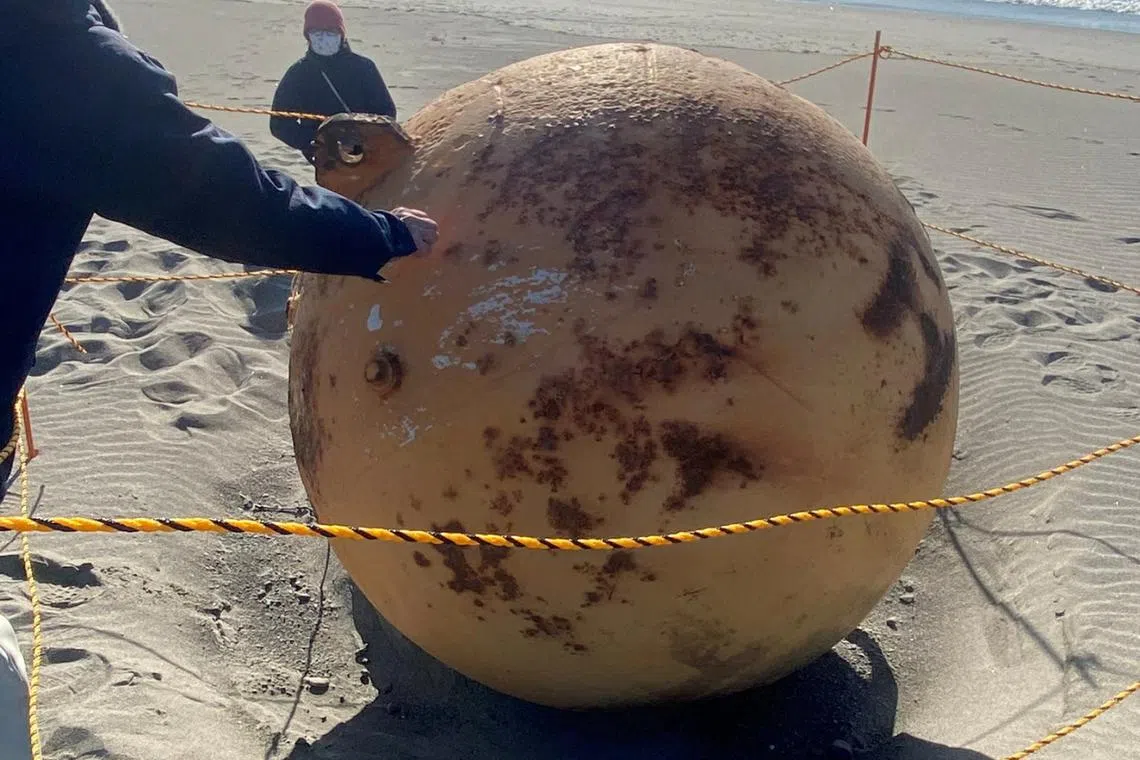Mysterious ‘Dragon Ball’ removed from Japanese beach
Sign up now: Get ST's newsletters delivered to your inbox

The russet sphere appeared to be rusty and made of metal.
PHOTO: REUTERS
Follow topic:
A large, mysterious metal sphere that washed up on a beach
Japanese media released footage showing the sphere, which was 1.5m wide and weighed 300kg, being removed from a beach in Hamamatsu.
Hamamatsu is a coastal city in Japan’s main island of Honshu.
According to a BBC article, local officials in Hamamatsu said the sphere would be stored “for a certain period of time” and then “disposed of”.
Some people have questioned why the authorities have not shared details about the sphere.
“I think everyone in Hamamatsu city was worried and curious about what it was about, but I’m relieved that the work is over,” a local official told Japanese media.
Hamamatsu’s local civil engineering office said it “considers it to be a foreign-made buoy”.
Some social media users have voiced embarrassment over the whole episode.
“I can’t believe officials from a country surrounded by ocean don’t recognise a ball buoy,” read one tweet.
“OMG! It’s a steel mooring buoy, people. I’m embarrassed to be Japanese,” said another.
Earlier this week, Japanese public broadcaster NHK released footage showing two officials on the beach looking at the russet sphere, which appeared to be rusty and made of metal.
Local residents in Hamamatsu have described the sphere as “Godzilla egg”, “mooring buoy” and “from outer space”, after an unidentified local man alerted the police upon noticing the unusual object on the beach.
Some said it resembled something from the popular Japanese manga series Dragon Ball, and others believed it was an unidentified flying object that had fallen from the sky.
The police and bomb squad were called in to check on the sphere.
Professor Mark Inall, an oceanographer at the Scottish Association for Marine Science, told the BBC that he knew what the sphere was “instantly”.
“It’s very recognisable,” he said. “We use (them) to keep instruments floating in the ocean.”
They often wash up on the coast of Scotland, he added.
Although Prof Inall said he was surprised that the sphere was not identified more quickly, he acknowledged that the public would not necessarily have known what it was.
“It could be confused for a World War II mine... but those would have spikes sticking out of them,” he said.
Prof Inall also said that buoys can float in the ocean for decades, and can lose their markings and get rusty when they wash ashore.
They can break free from their anchorage either in a violent storm or from being pulled by a big fishing vessel, he added.
The TV footage of the sphere also prompted speculation on social media after Japan said it “strongly suspected” several Chinese spy balloons had been spotted over its territory in recent years.
On Wednesday, Japan expressed its concerns to China about suspected surveillance balloons spotted over its skies at least three times since 2019 – an allegation it first made last week. Beijing denies claims of espionage.
The discovery of the sphere comes after the United States shot down what it suspected was a Chinese spy balloon earlier in February. It was shot down off the coast of South Carolina and recovered in the Atlantic Ocean.


